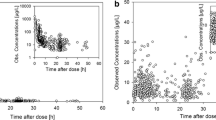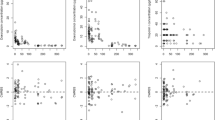Abstract
Purpose
Clinical studies indicate that anthracycline cardiotoxicity increases with patient age. This may be due to altered pharmacokinetics or pharmacodynamics. A parameter termed 'early clearance' has been shown to decrease with age in patients receiving intravenous doxorubicin. This parameter, as defined, has no immediate relationship to any physiologically based pharmacokinetic parameter. We therefore reevaluated the pharmacokinetic data to better define the relationship between doxorubicin disposition and patient age.
Methods
Four studies provided a total of 56 patients with evaluable pharmacokinetics. The volume of the central compartment, Vc, the distribution clearance, CLd, and total body clearance, CL, were determined for each patient and regressed against age. A physiologically based pharmacokinetic (PBPK) model for doxorubicin was also used to evaluate the effects of age on doxorubicin disposition. Published blood flows associated with various patient ages were used to simulate plasma and tissue doxorubicin concentrations. The relationship between CLd and initial tumor regression was also evaluated.
Results
No correlation was found between Vc and age (P>0.05). A highly significant correlation was observed between CLd and age (P<0.0005) and there was a mild but significant relationship between CL and age (P<0.01). Use of the PBPK model with different age-related blood flows yielded virtually identical parameter values to the clinical data analyzed. Furthermore, relative tissue AUCs simulated in old and young patients compared well with those reported for daunorubicin disposition in young and old rats. In addition, a linear relationship was observed between initial tumor regression and CLd.
Conclusions
Initial concentrations of doxorubicin following intravenous administration are higher in the elderly due to a decrease in CLd rather than in Vc. On the basis of simulations with the PBPK model, the reduced CLd appears to be related to altered regional blood flows in the elderly, and such changes may be of clinical significance.





Similar content being viewed by others
References
Steinherz LJ, Yahalom J (1997) Toxicity. In: DeVita VT Jr, Hellman S, Rosenberg SA (eds) Cancer: principles and practice of oncology. Lippincott-Raven, Philadelphia New York, p 2739
Shureiqi I, Cantor SB, Lippman SM, Brenner DE, Chernew ME, Fendrick AM (2002) Clinical and economic impact of multiple gated acquisition scan monitoring during anthracycline therapy. Br J Cancer 86:226
Von Hoff DD, Layard MW, Basa P, Davis HL Jr, Von Hoff AL, Rozencweig M, Muggia FM (1979) Risk factors for doxorubicin-induced congestive heart failure. Ann Intern Med 91:710
Jensen BV, Skovsgaard T, Nielsen SL (2002) Functional monitoring of anthracycline cardiotoxicity: a prospective, blinded, long-term observational study of outcome in 120 patients. Ann Oncol 13:699
Pai VB, Nahata MC (2000) Cardiotoxicity of chemotherapeutic agents: incidence, treatment and prevention. Drug Saf 22:263
Cusack BJ, Young SP, Vestal RE, Olson RD (1997) Age-related pharmacokinetics of daunorubicin and daunorubicinol following intravenous bolus daunorubicin administration in the rat. Cancer Chemother Pharmacol 39:505
Robert J, Illiadis A, Hoerni B, Cano J-P, Durand M, Lagarde C (1982) Pharmacokinetics of adriamycin in patients with breast cancer: correlation between pharmacokinetic parameters and clinical short-term response. Eur J Clin Oncol 18:739
Robert J, Hoerni B, Vrignaud P, Lagarde C (1983) Early-phase pharmacokinetics of doxorubicin in non-Hodgkin lymphoma patients. Dose-dependent and time-dependent pharmacokinetic parameters. Cancer Chemother Pharmacol 10:115
Robert J, Vrignaud P, Iliadis A, Egbhali H, Hoerni B (1983) Etude pharmacocinetique de la doxorubicine dans le traitement des lymphomes malins non Hodgkiniens. Nouv Rev Fr Hematol 25:91
Robert J, Hoerni B (1983) Age dependence of the early-phase pharmacokinetics of doxorubicin. Cancer Res 43:4467
Robert J, Bui NB, Vrignaud P (1987) Pharmacokinetics of doxorubicin in sarcoma patients. Eur J Clin Pharmacol 31:695
Veng-Pedersen P (1989) Mean time parameters in pharmacokinetics definition, computation and clinical implications (part II). Clin Pharmacokinet 17:424
Gibaldi M, Perrier D (1982) Multicompartment models. In: Gibaldi M, Perrier D (eds) Pharmacokinetics. Dekker, New York, p 68
Harris PA, Gross JF (1975) Preliminary pharmacokinetic model for adriamycin (NSC-123127). Cancer Chemother Rep 58:819
Chan KK, Cohen JL, Gross JF, Himmelstein KJ, Bateman JR, Tsu-Lee Y, Marlis AS (1978) Prediction of adriamycin disposition in cancer patients using a physiologic, pharmacokinetics model. Cancer Treat Rep 62:1161
Wada DR, Bjorkman S, Ebling WF, Harashima H, Harapat SR, Stanski DR (1997) Computer simulation of the effects of alterations in blood flows and body compositions on thiopental pharmacokinetics in humans. Anesthesiology 87:884
Macey R, Oster G, Zahnley T (2000) Berkeley Madonna user's guide version 8.0. University of California, Department of Molecular and Cellular Biology, Berkeley
Avram MJ, Krejcie TC, Henthorn TK (1990) The relationship of age to the pharmacokinetics of early drug distribution: the concurrent disposition of thiopental and indocyanine green. Anesthesiology 72:403
Yancik R (1997) Cancer burden in the aged: an epidemiologic and demographic overview. Cancer 80:1273
Hammerlein A, Derendorf H, Lowenthal DT (1998) Pharmacokinetic and pharmacodynamic changes in the elderly. Clinical implications. Clin Pharmacokinet 35:49
Balducci L, Extermann M (1997) Cancer chemotherapy in the older patient: what the medical oncologist needs to know. Cancer 80:1317
Storm G, van Hoesel QG, de Groot G, Kop W, Steerenberg PA, Hillen FC (1989) A comparative study on the antitumor effect, cardiotoxicity and nephrotoxicity of doxorubicin given as a bolus, continuous infusion or entrapped in liposomes in the Lou/M Wsl rat. Cancer Chemother Pharmacol 24:341
Preisler HD, Gessner T, Azarnia N, Bolanowska W, Epstein J, Early AP, D'Arrigo P, Vogler R, Winton L, Chervenik P, et al (1984) Relationship between plasma adriamycin levels and the outcome of remission induction therapy for acute nonlymphocytic leukemia. Cancer Chemother Pharmacol 12:125
Author information
Authors and Affiliations
Corresponding author
Appendix
Appendix
The differential equations for the PBPK model of doxorubicin
For lung:
For plasma:
For liver:
For kidneys:
For lean tissue:
For adipose tissue:
For bone marrow:
For gastrointestinal tissue:
For spleen:
Nomenclature
- D:
-
Dose for i.v. bolus administration, nanograms
- C:
-
Concentration, nanograms per milliliter
- CL:
-
Total body clearance, milliliters per minute
- Q:
-
Plasma flow rate, milliliters per minute
- R:
-
Tissue-to-plasma equilibrium distribution ratio for linear binding
- V :
-
Volume, milliliters
Subscripts
- G:
-
Gastrointestinal tissue
- K:
-
Kidney
- LI:
-
Liver
- L:
-
Lean tissue
- P:
-
Plasma
- B:
-
Bone marrow
- H:
-
Heart
- A:
-
Adipose tissue
- S:
-
Spleen
- LU:
-
Lung
Rights and permissions
About this article
Cite this article
Li, J., Gwilt, P.R. The effect of age on the early disposition of doxorubicin. Cancer Chemother Pharmacol 51, 395–402 (2003). https://doi.org/10.1007/s00280-002-0554-z
Received:
Accepted:
Published:
Issue Date:
DOI: https://doi.org/10.1007/s00280-002-0554-z




